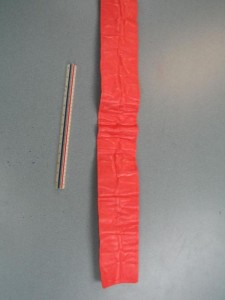It is particularly more difficult to make a splint for the hand, thus a slightly

different set of instructions may be advised to ensure proper splinting.
It is particularly more difficult to make a splint for the hand as compared to the limbs and other parts of the body. Thus, there is a slightly different set of instructions that are advised to ensure proper splinting of the hand. A fracture in the hand, similar to any kind of fracture, can be very painful, consequently even slight movements can worsen in the pain. Placing temporary hand splints should be done immediately after the injury.
Before making a splint for the hand, it is necessary to treat any wounds in the hand. If there is any bleeding, ensure that the bleeding has stopped. Give care to all wounds before applying the splint. After creating a splint for the hand, ensure that there is normal circulation in the hands. If there are signs of poor circulation, loosen the splint or remove.
How to Make a Splint for the Hand: Materials Needed
Temporary hand splints can be made from everyday materials available in the house or in the house. The following materials are needed to make a splint for the hand
- Washcloth, ball of socks, or tennis ball
- Cotton balls or gauze
- Newspapers, rolled up cloth
- Belt, ties or clean cloth
- Plaster of Paris
- Warm water
- Ice pack
How to Make a Splint for the Hand: Makeshift Hand Splint
Once all materials are prepared to create a makeshift hand splint, prepare the hand for splinting.
- The person’s finger should be closed around the ball of socks or tennis ball.
- Place small pieces of cotton or gauze between each finger. This will help absorb sweat.
- Find a splint that is hard, straight and at least as long as the distance from the middle of the forearm to the tips of the fingers. It is generally ideal to use an object that follows the shape of the arm, wrist and hand.
- Use gauze, a clean cloth or belt to wrap the fractured area. Wind it securely around the splint and wrist area for the splint to remain in place. Do not place wraps directly above the injured hand to further injuries.
- Place ice on the top of the hand. Do not apply ice directly to the hand, instead wrap it with a towel or cloth. to avoid further injuries.
How to Make a Splint for the Hand: Cast Splint
Another option is to create a cast splint for the hand, although this may require more materials that are not readily available at home. The following is the procedure to make a cast splint.
- Place a splint under the injured hand. Ensure that the injured hand is straight with fingers slightly bent around the end of the splint.
- Using four layers of cotton gauze or padding, wrap the splint starting around the hand, making its way to the arm to at least half-way through the elbow.
- Place cotton pieces of gauze in between each fingers.
- Dip the plaster of Paris strips in warm water and wrap them around the cotton gauze or padding. Do this until the padded area is completely covered. Do not use hot, scalding water to avoid further injuries.
Disclaimer: This article does not provide medical advice and should
not be substituted for formal training. Seek medical attention when necessary. To learn how to properly make a splint for the hand, enrol in First Aid Courses and CPR Courses with St Mark James Training.
Online Sources:
http://www.healthline.com/health/how-to-make-a-splint?toptoctest=expand
http://www.wikihow.com/Splint-a-Fractured-Hand
